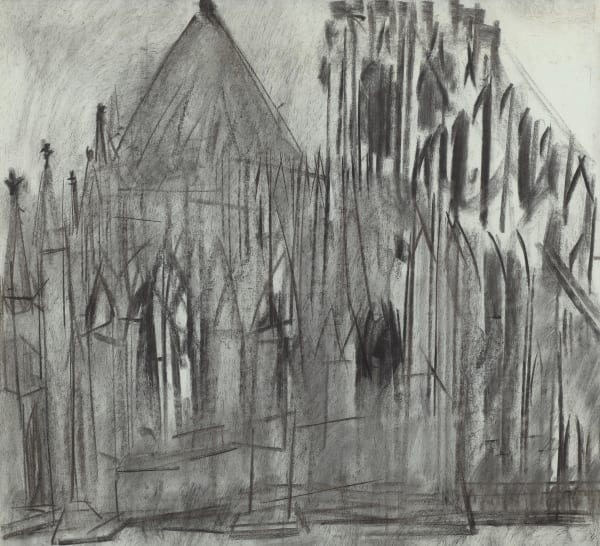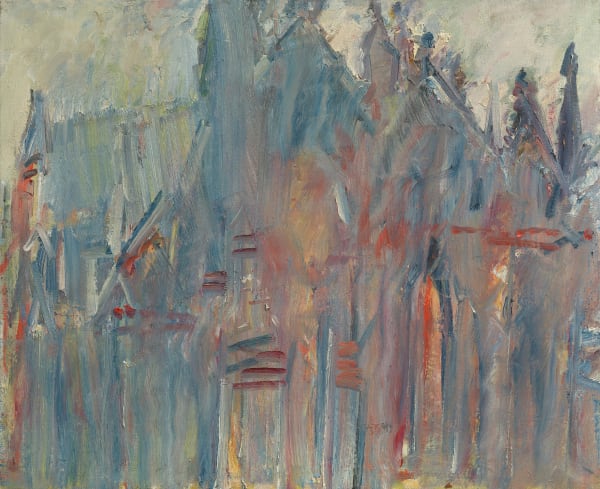To act as a counter-point to John Piper’s exhibition, we have chosen to exhibit a selection of Dennis Creffield’s cathedral drawings. The cathedral drawings were originally an Arts Council commission from 1985 to draw every medieval Cathedral in England. On receiving the commission, Creffield acquired a camper van and took to the road, producing dozens of large scale charcoal drawings and, when back in the studio, a small number of related oils. The subsequent touring exhibition, which covered 14 public galleries over a 2 year period, did much to establish Creffield’s reputation and are still the principal entry point for many who are new to his work. Many of the drawings entered the Arts Council’s permanent collection, with further significant holdings at Tate Britain and Pallant House (Chichester).
Although there was little to link the artists socially and professionally during their respective careers, despite the decades of overlap, there are obvious similarities in some of their subject matter. More pertinently, there are also deeper connections between the two artists, particularly with reference to their inherent ‘Englishness’ and their relationship to landscape painting.
Both Creffield and Piper were engrossed in amassing an “anthology of good places” (a phrase employed by David Fraser Jenkins in his text for the exhibition catalogue to accompany Piper’s 1993 Tate retrospective). Both artists were careful to avoid including any overt human presence in their depictions of churches and cathedrals. For both artists, the buildings alone were sufficient in representing humanity both symbolically and metaphorically. To include figures would contemporise the images, but while both artists wished to depict the buildings at a certain moment in time, they were not interested in creating historical documents.
Piper, generally speaking, was not interested in depicting modern architecture. Creffield was more flexible in this aspect, but both were interested in depicting buildings that had been shaped and formed by specific purpose and the environment around them. Piper includes (in often wildly gestural strokes) the flora surrounding and encroaching on his churches. Creffield, if confronted by a building shrouded in low cloud, would obscure architectural details in a blur of rubbed charcoal. Both artists were painting a moment in time, but a moment that might have been witnessed by a dozen different generations.
Creffield and Piper both represented buildings as dynamic, ‘living’ objects. They are not interested in recording precise detail (at least not in its entirety), but instead in recording one’s experience of viewing the building, however fleetingly. These are not ‘architectural drawings’ – they are simply drawings which happen to represent architecture. Neither artists are interested in nostalgic reverence, but both are acutely aware of their subjects historical and symbolic importance.
Both were engaged directly and purposefully in the English landscape tradition; Creffield and Piper both had a great reverence for JMW Turner and the pastoral tradition. Both artists were resolutely modern and romantic. They chose historic subject matter to present timeless images which will never loose relevance, and whose narrative is constantly evolving.
John Piper: 22nd February – 10th March 2023 (catalogue available on request)
Dennis Creffield – Cathedrals: to run concurrently (online Viewing Room presentation)
-
 Chichester Cathedral, 1987Dennis Creffield
Chichester Cathedral, 1987Dennis Creffield -
 Lichfield Cathedral from the SouthDennis Creffield
Lichfield Cathedral from the SouthDennis Creffield -
 Peterborough Cathedral: West front, 1989Dennis Creffield
Peterborough Cathedral: West front, 1989Dennis Creffield -
 Bourges: West Front, circa 1990Dennis Creffield
Bourges: West Front, circa 1990Dennis Creffield -
 Norwich Cathedral: the spire from the cloisters, 1987Dennis Creffield
Norwich Cathedral: the spire from the cloisters, 1987Dennis Creffield -
 Norwich Cathedral, circa 1987Dennis Creffield
Norwich Cathedral, circa 1987Dennis Creffield -
 York Cathedral: Central Tower and Chapter House, 1987Dennis Creffield
York Cathedral: Central Tower and Chapter House, 1987Dennis Creffield -
 Ely Cathedral from the East, 1989Dennis Creffield
Ely Cathedral from the East, 1989Dennis Creffield -
 Amiens Cathedral: West Front, 1990Dennis Creffield
Amiens Cathedral: West Front, 1990Dennis Creffield -
 Amiens; West Front, 1990Dennis Creffield
Amiens; West Front, 1990Dennis Creffield -
 Salisbury (version 1), 1988Dennis Creffield
Salisbury (version 1), 1988Dennis Creffield -
 Salisbury Cathedral; West End, 1988Dennis Creffield
Salisbury Cathedral; West End, 1988Dennis Creffield












